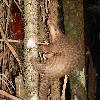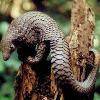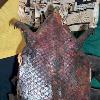

Pangolin, Tags: Pangolin View |
Tags: Pangolin View |
Tags: Pangolin View |
|||||||||
Pholidota ordo_authority = Weber (Max Wilhelm Carl Weber), 1904 familia = Manidae familia_authority = Gray (John Edward Gray), 1821 genus = Manis genus_authority = Linnaeus (Carolus Linnaeus), 1758 subdivision_ranks = Species subdivision = Manis culionensis Manis gigantea (Giant Pangolin) Manis temminckii (Ground Pangolin) Manis tricuspis (Tree Pangolin) Manis tetradactyla (Long-tailed Pangolin) Manis crassicaudata (Indian Pangolin) Manis pentadactyla (Chinese Pangolin) Manis javanica (Sunda Pangolin)
A pangolin (pronEng?p�???l?n), also scaly anteater or tenggiling, is a mammal of the order (Scientific classification) Pholidota. There is only one extant family (family (biology)) (Manidae) and one genus (Manis) of pangolins, comprising eight species. There are also a number of extinct taxa. Pangolins have large keratin scales (scale (zoology)) covering their skin and are the only mammals with this adaptation. They are found in tropical regions of Africa and Asia. The name "pangolin" derives from the Malay (Malay language) word pengguling ("something that rolls up"). Pangolins are nocturnal animals, and use their well-developed sense of smell to find insects. The long-tailed pangolin is also active by day. Pangolins spend most of the daytime sleeping, curled up into a ball.
Pangolins were classified with various other orders, for example Xenarthra, which includes the ordinary anteaters, sloths, and the similar-looking armadillos. But newer genetic evidence indicates that their closest living relatives are the Carnivora, with which they form the clade Ferae. Some paleontologists have classified the pangolins in the order Cimolesta, together with several extinct groups.
Fossil Range: Fossil rangePaleoceneRecent
Regnum: Animalia
Phylum: Chordata
Classis: Mammalia
Infraclassis: Eutheria
Superordo: Laurasiatheria



